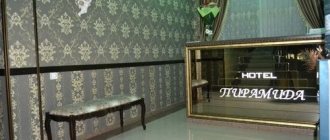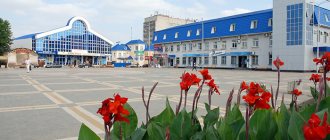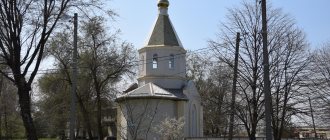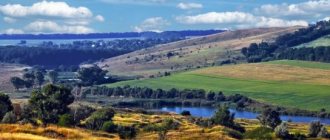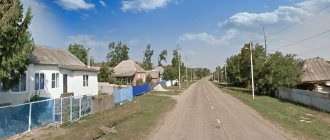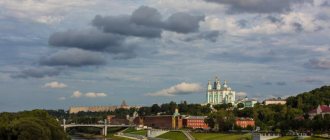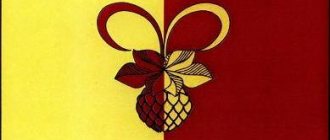Novoanninsky
(Volgograd region)
OKATO code:
18238501
Founded: Urban settlement since:
1936
City since:
1956 City of district subordination (Novoanninsky district, Volgograd region)
Center:
Novoanninsky district
Telephone code (reference phone)
| 84447***** | — |
Deviation from Moscow time, hours:
0
Geographic latitude:
50°31′
Geographic longitude:
42°40′
Altitude above sea level, meters:
90 Sunrise and sunset times of the Sun and Moon in the city of Novoanninsky
Map
| Novoanninsky: maps |
Novoanninsky: photo from space (Google Maps) Novoanninsky: photo from space (Microsoft Virtual Earth)
| Novoanninsky. Nearest cities. Distances in km. on the map (in brackets along roads) + direction. Using the hyperlink in the distance , you can get the route (information courtesy of the AutoTransInfo website) | |||
| 1 | Preobrazhenskaya | 37 (39) | NE |
| 2 | Alekseevskaya | 42 (39) | SW |
| 3 | Novonikolaevsky | 55 (57) | NW |
| 4 | Uryupinsk | 55 (79) | NW |
| 5 | Mikhailovka | 64 (60) | SE |
| 6 | Nekhaevskaya | 65 (144) | Z |
| 7 | Kumylzhenskaya | 70 (105) | YU |
| 8 | Povorino | 81 (93) | WITH |
| 9 | Sands (Voronezh region) | 82 (111) | WITH |
| 10 | Yelan | 89 (88) | NE |
| 11 | Novokhopyorsk | 98 (137) | NW |
| 12 | Novokhopyorsky (Voronezh region) | 99 (141) | NW |
| 13 | Borisoglebsk | 102 (108) | NW |
| 14 | Serafimovich | 103 (131) | YU |
| 15 | Samoilovka (Saratov region) | 104 (113) | NE |
| 16 | Danilovka | 104 (137) | IN |
| 17 | Frolovo | 108 (103) | SE |
| 18 | Gribanovsky (Voronezh region) | 114 (119) | NW |
| 19 | Zabrody (Voronezh region) | 116 () | Z |
| 20 | Kalach | 118 (200) | Z |
| 21 | Veshenskaya (Rostov region) | 118 (501) | SW |
| 22 | Balashov | 120 (175) | WITH |
a brief description of
Located on the left bank of the river. Buzuluk (Don basin), 254 km northwest of Volgograd. Railway Filonovo station.
Territory (sq. km): 63
Information about the city of Novoanninsky on the Russian Wikipedia site
Historical sketch
Workers' settlement of Novo-Annensky since 1936. City since 1956.
Economy
Factories: electromedical equipment, asphalt concrete, foundry-mechanical, brick, auto repair.
Food industry enterprises: grain processing plant, butter and cheese plant, meat and poultry plant.
Grains are grown in the Novoanninsky district. Cattle are raised. Poultry farming.
| Population by year (thousands of inhabitants) | |||||||
| 1939 | 15.2 | 1996 | 20.9 | 2007 | 18.4 | 2015 | 16.8 |
| 1959 | 18.7 | 1998 | 20.7 | 2008 | 18.2 | 2016 | 16.7 |
| 1967 | 20 | 2000 | 20.4 | 2010 | 17.9 | 2017 | 16.4 |
| 1970 | 20.5 | 2001 | 20.1 | 2011 | 17.9 | 2018 | 16.3 |
| 1979 | 20.9 | 2003 | 19.5 | 2012 | 17.5 | 2019 | 16.1 |
| 1989 | 20.9 | 2005 | 18.9 | 2013 | 17.3 | 2020 | 15.9 |
| 1992 | 20.9 | 2006 | 18.6 | 2014 | 17.0 | 2021 | 15.8 |
History of our area
The beginning of human development of the territory of the Novoanninsky district
The territory of the region has been inhabited and developed by people for many centuries. Five to four thousand years BC there were Neolithic sites on the Novoanninskaya land. The burials of a Neolithic settlement in the area of the village of Staroanninskaya were found by an archaeological expedition led by Volgograd archaeologist Vladimir Ilyich Eremin in 1976.
Traces of human existence in the Bronze Age, objects of the Pokrovskaya, Srubnaya, Catacomb, and Sarmatian cultures were discovered during archaeological excavations of burial mounds carried out by archaeologists in the area in the second half of the twentieth and early 21st centuries. Sarmatian tribes roamed the Buzuluk steppes throughout all periods of their existence, right up to the 3rd century AD.
The regional museum exhibits objects of paleontology and various archaeological cultures - from Timber to Late Sarmatian. Before the appearance of the Cossacks on the Don and its tributaries, including along Buzuluk, the territory that the Cossacks began to occupy starting in the 16th century was called the Polovtsian or Wild Field.
In the Wild Field, states arose and disappeared, replaced, enslaved each other, various tribes and peoples mixed: Slavic, Turkic.
Cossack period in the history of the region
Since the 16th century, the Don Cossacks have firmly settled in the Wild Field between the Don and Khopry.
According to the information of the Don historian I. Sulin and Doctor of Historical Sciences S. Ryabov, the first Cossack settlements in the region were:
1. The village of Berezovskaya (Berezov town) was founded in 1685 according to a military charter.
2. Stanitsa Durnovskaya (Bad Town) has been mentioned in sources since 1698.
3. Stanitsa Martynovskaya. (Martynov town) The year of foundation is unknown. Mentioned since 1698
4. Stanitsa Filonovskaya. (Filonovsky town). The year of foundation is unknown. Listed since 1685
5. Stanitsa Chernovskaya. (Chernovskaya town). The year of foundation is unknown. It was first mentioned in 1685. In 1762 it was moved to a new location. In 1835 it was renamed the village of Anninskaya.
6. Yaryzhenskaya village. (Yarygin town.) The year of foundation is unknown.
First mentioned since 1698.
These Cossack towns were located along the banks of the Buzuluk, a tributary of the Khopr.
In the process of exploration and development of the territory of compact residence of the Don Cossacks, its administrative and territorial division was formed.
In the pre-revolutionary period, the territory of the district was part of the Khopersky district of the Don Army Region. Since 1857, the district village of the Khopersky district has been the village of Uryupinskaya. Other villages of the Cossack district were yurt. Subordinate to the yurt villages were nearby farmsteads located on the village lands.
Defenders of the Fatherland, Cossacks, natives of our Buzuluk villages and farms, were participants in all the wars waged by the Russian state. They came back from military campaigns with awards and trophies.
Egor Fedosov, a Cossack of the 9th Don Cossack Regiment from the village of Filonovskaya, was awarded the Insignia of the Military Order of St. George, 4th degree, during the Russian-Turkish War of 1877-1878.
Abukhov Efim, a Cossack of the 9th Don Cossack Regiment from the village of Filonovskaya, was awarded the Insignia of the Military Order of the 4th degree of St. George for his distinction in the capture of the city of Plevna in the Russian-Turkish War of 1877-1878.
Kolobrodin Philip, a Cossack of the 9th Don Cossack Regiment from the village of Filonovskaya, was awarded the Insignia of the Military Order of St. George during the Russian-Turkish War of 1877-1878.
The main properties of the Cossack character - loyalty to the oath and the Fatherland - also manifested themselves in the First World War.
To date, there is information about the awarding of more than a hundred Cossacks - fellow countrymen - with the Cross of St. George. Twenty of them became Full Knights of St. George.
Novoanninsky district. Stages of the journey
After the October Revolution of 1917, the lands and settlements of the modern Novoanninsky district were part of various administrative-territorial structures that arose in the northeast of the current Volgograd region.
During the administrative-territorial reform of 1928-1929. on the lands of the former Cossack villages of the Khopersky District - Anninskaya, Durnovskaya Filonovskaya, Yaryzhenskaya, partly on the lands of the villages of Alekseevskaya, Arzhanovskaya, Preobrazhenskaya, Pavlovskaya, settlements of the 34th department of the Military Lands of the Don Army Region, by a resolution of the All-Russian Central Executive Committee of the RSFSR dated July 23, 1928, the Novoanninsky District was established as part of the Khopyorsky District districts of the Lower Volga region.
In total, the district at the time of its formation included 49 village councils. The regional center became the village of Novo-Annenskaya, now the city of Novoanninsky. Novoanninsky changed its name several times during its existence. Initially, it was the village of Privokzalny, which arose at the Filonovo station during the construction of the Gryaze - Tsaritsyn railway (1869 - 1871).
On December 29, 1909, the village of Privokzalny was renamed the village of Samsonov. In March 1918, the Soviet government changed the name and status of the settlement - the Samsonov farm became the village of Novo-Anninskaya.
Since August 1, 1936, the village of Novo-Anninskaya was called the workers' settlement Novo-Anninsky. In 1956, the workers' settlement acquired city status.
The administrative reform of 1929 preceded the reorganization in the economic, political, and cultural life of the country.
In 1929, collective farms were created in the region at an accelerated pace.
By November 15, the artels named after Sverdlov, named after Demyan Bedny, "Trudovik" and two large communes were formed: "Fortress of Communism", transformed from the commune "Fortress" and the Durnovsky partnership "Proletary", reorganized into the commune named after Stalin. In addition to these largest farms, 21 more artels have been created.
In 1930, an agricultural technical school was opened in the district, which became a personnel forge for the entire Khoper district.
The thirties of the 20th century are characterized by the rapid growth of collective farms, state farms, and MTS.
By 1935, there were 6 postal and 4 postal-telegraph-telephone agencies in the area. Retail trade is represented by a district store, a cultural store, 48 shops and 33 stalls. Medical institutions: hospital with 80 beds (district center), 3 outpatient clinics (1 in the regional center), 8 paramedic stations. Among the cultural and educational institutions there are 30 primary, 7 incomplete, 4 secondary schools, an agricultural technical school, 5 clubs, 12 huts - reading rooms, sound cinema and film transport.
In 1939, leading workers and farms of the region represented the Novo-Annensky district and the Stalingrad region at the first All-Union Agricultural Exhibition in Moscow.
In the pre-war years, Novoanninsky grain growers became one of the initiators of the All-Union competition for obtaining hundred-pound harvests.
In the abrupt revolutionary transformations, in the difficulties of war and post-war times, the Novoanninsky district rose and developed.
The Great Patriotic War became one of the most dramatic events in the annals of the region. On the second day of the war, the first trains with mobilized Novoannins were sent to Stalingrad.
Equipment and draft power were also taken for the needs of the front. Machine operators and combine operators were replaced by their fathers, wives, mothers, and teenagers.
Ten women’s and youth tractor teams have been created in the Deminsk and Novoanninskaya MTS under the leadership of experienced machine operators: A. Salnikov, L. Tarasov, F. Gubanov, G. Anikeev, A. Fonin and others. Sixteen-year-old girls became tractor drivers: A. Sergeeva, A. Denisova, M. Atarshchikova and many others. In 1941, the Rassvet industrial artel began casting housings and base plates for mortars.
The women of the district greeted the first wounded soldiers and officers in the hospitals in a motherly manner. Collective farms provided meat, milk and other products for them. Doctors spent sleepless nights at the beds of the seriously wounded: A. I. Larionov, D. Yachmeneva, A. Gogolicheva, M. Uvarova, A. Ilyina, sisters: N. Kolpakova, A. Bocharova, M. Skvortsova, F. Terentyeva, P. Shcherbakova and other medical workers.
The Novoannins not only worked hard for the front, they donated their personal savings and belongings to the defense fund. 11,500 pairs of felt boots were made from the wool donated by the Novoannin residents, 22 thousand pairs of mittens were knitted, many scarves and gloves. A collective farmer from the Gogolichevo farm of the Cherkesovsky village council, V.V. Konev, used his own savings to buy a fighter plane and gave it to the combat pilot three times Hero of the Soviet Union, Ivan Kozhedub. In 1944, the collective farmers of the Bolshevik Banner artel fulfilled the grain procurement plan ahead of schedule and delivered 3 thousand poods of grain to the Red Army fund in excess of the plan. In addition, members of the artel donated 2,538 pounds of grain from their personal reserves to the Red Army fund. Collective farmer of the Bolshevik Banner artel N.I. Maslov contributed 100 thousand rubles of personal savings to the construction of a tank column. Novoannin residents donated personal jewelry made of precious metals to the defense fund and signed up for a war loan. In a short time, 2.5 million rubles were collected for the construction of the “Heroic Stalingrad” aircraft squadron, and about two million rubles for the construction of the “Novoanninsky Collective Farmer” tank column.
In the workshops of the Novoanninskaya MTS in the summer of 1942, 28 guns, 53 guards mortars, and 10 U-2 night bombers were repaired.
The foundry of the Rassvet artel produced shells of mines and base plates for mortars. There was a workshop for the production of Molotov cocktails for the destruction of fascist tanks.
More than 18 thousand of our fellow countrymen defended the country on all fronts of the Great Patriotic War, almost half of them did not return home.
The region formed a volunteer Cossack cavalry regiment, which was reorganized into the 39th Guards in 1942 for excellent military operations in the North Caucasus. Our fellow countrymen, as part of the 5th Don Cavalry Corps, reached the Austrian Alps.
Ten Novoannin residents were awarded the title of Hero of the Soviet Union:
P.G. Baranov, I.K. Boronin, N.A. Kozhushkin, I. A. Popov. P.G. Pudovkin, who repeated the feat of A. Matrosov, A.I. Filippov, A.I. Kharitonov. G.S. Cheprunov, V.I. Shevchenko, A. A. Shcherbakov. I.Ya Dronov became a full holder of the Order of Glory of three degrees. Thousands of soldiers were awarded orders and medals. 14 Novoannin residents were awarded the Order of Lenin, four were awarded the Commander’s Order of Alexander Nevsky.
The post-war years became a time of growth in production and labor success for our region. In creative work for the benefit of the region, many notable workers, production organizers, well-known people in the region and the country, awarded with high awards from the Motherland, were formed.
In 1948, a group of Novoannin residents were awarded the title of Heroes of Socialist Labor for achieving record harvests over large areas of land. In total, 18 of our fellow countrymen were awarded this high title: I.A. Azovtsev, F.I. Fetisov, F.S. Kozhushkina, M.T. Zhulinsky, S.S. Andreev, P.N. Sergeev, I.D. Gusev, A.I. Aksenova, M.V. Tarasova, N.P. Logvinov, V.I. Romanova, A.F. Seleznev, N.A. Slashilina, A.V. Zvyagintseva, A.A. Afonina, G.T. Tkacheva, A.N. Gusev, P.Z. Gvozdkov, who was the first in the region to be awarded this title twice. No other district of the Volgograd region has such a “stellar” harvest of Heroes of Labor.
More than two hundred workers of the region were awarded the Order of Lenin. Twice this high award was awarded to P.V. Nagnibeda, A.V. Zvyagintseva, A. A. Afonina, V.S. Bazanaeva.
In 1950, the gross grain harvest increased by 44 percent compared to 1945. The production of agricultural and livestock products increased every year.
In the 50-60s, the Novoanninsky district was repeatedly approved as a participant in the Exhibition of Achievements of the National Economy of the USSR.
In 1960, the area was one of the first in the region to be electrified.
In the same year, the Novoannin residents handed over to the state 4,032,941 centners of grain, or 1.6 annual plan. The yield was 18.4 centners per hectare. The district was awarded a first degree diploma from the USSR Exhibition of Economic Achievements.
In 1976, the Novoannin residents achieved a record grain harvest of 26.5 centners per hectare. The Motherland received 218 thousand tons of Novoanninsky bread.
The life and fate of the region is always inextricably linked with the fate of the country.
The Novoannins have always defended and defended the state interests of the country in zones of military conflicts and hot spots on the planet.
In recent years, 450 Novoannin residents served in various areas of military conflicts, fulfilling, among other things, international duty. Ninety of our fellow countrymen fought in Afghanistan, one in Yugoslavia, three in Tajikistan, 5 in the Georgian-Abkhaz conflict; in the “hot spots” of Russia - Dagestan - 43 people, of which 20 Novoannins became participants in the hostilities; in the Chechen Republic - 301 people, in the Ossetian-Ingush conflict - 7 people. In combat, 21 soldiers were injured, four of our fellow countrymen died in the Chechen Republic. For participation in hostilities in Afghanistan, six Novoannin residents were awarded the Order of the Red Star. In battles in military conflict zones, eight Novoannin residents were awarded the Order of Courage, one was awarded the Order of Merit for the Fatherland. The activity and patriotism of our fellow countrymen was also evident during the liquidation of the consequences of the accident at the Chernobyl nuclear power plant. Seventy-eight people became liquidators of the consequences of the disaster at the Chernobyl nuclear power plant.
Novoanninsky district is the breadbasket of the Volgograd region.
Since its formation, the Novoanninsky district has been the main breadbasket of the Volgograd region. The region traditionally has high rates of harvesting grain crops.
The start of the victorious harvests was given in 1930. At that time, the Novoannin residents handed over more grain to the state than the entire Khopersky district in 1927.
Awards and achievements
In 1939, the leading workers and farms of the region were included in the Book of Honor of the All-Union Agricultural Exhibition of the USSR.
In 1944, following the results of the All-Union Socialist Competition of Districts, the Council of People's Commissars decided: to award the challenge Red Banner of the State Defense Committee and give a cash prize to the Novo-Annensky District of the Stalingrad Region for the competition for obtaining a high harvest. At that time, only 15 agricultural regions in the country received such an award. The Stalingrad region was represented among the awarded by the Novo-Annensky district.
In 1955, the Novo-Annensky district was awarded a second degree diploma as a participant in the Stalingrad Regional Agricultural Exhibition for obtaining a high yield of grain crops and exceeding the plan for delivering grain to the state by collective and state farms in the region.
In 1958, the Main Committee of the All-Union Agricultural Exhibition awarded the Novoanninsky district a second degree diploma and a bonus.
In 1974, the Central Committee of the CPSU, the Council of Ministers of the USSR, the All-Union Central Council of Trade Unions and the Central Committee of the Komsomol for achieving the highest results in the all-Union socialist competition for increasing production and procurement of agricultural and livestock products presented the Novoanninsky district of the Volgograd region with a challenge Red Banner.
In 1977, the district was awarded the Memorial Badge of the regional committee of the CPSU, the regional executive committee, the regional trade union committee and the regional committee of the Komsomol “For success in the struggle for bread in 1976.”
Based on the results of the 1978 harvest, the Volgograd regional committee of the CPSU and the executive committee of the regional Council of People's Deputies awarded the Novoanninsky district with a memorable sign and pennant “Golden Sheaf”.
In 2008, the head of the administration of the Volgograd region N.K. Maksyuta was awarded a Certificate of Honor from the Novoanninsky municipal district for the highest gross grain harvest in the initially recorded weight.
In 2014, the Novoanninsky municipal district, based on the results of the regional competition “Best Managers and Organizations of the Year,” was awarded the title “Best Municipal Formation of 2014.”
Novoanninsky municipal district
On December 21, 2004, in accordance with the Law of the Volgograd Region No. 970-OD, the district was given the status of a municipal district with the administrative center in the city of Novoanninsky.
The district includes 14 municipalities: 1 urban and 13 rural settlements.
Urban settlement Novoanninsky.
Amovskoye rural settlement. The administrative center is the village of the AMO state farm.
Berezovskoe rural settlement. The administrative center is the village of Berezovka 1st.
Bocharovskoye rural settlement. The administrative center is the village of Bocharovsky.
Galushkinskoye rural settlement. The administrative center is the Galushkinsky village.
Deminskoye rural settlement. The administrative center is the village of Deminsky.
Krasnokorotkovskoe rural settlement. The administrative center is the village of Krasnokorotkovsky.
Novokievskoe rural settlement. The administrative center is the village of Novokievka.
Panfilovskoe rural settlement. The administrative center is the village of Panfilovo.
Field rural settlement. The administrative center is the village of Polevoy.
Staroanninskoe rural settlement. The administrative center is the village of Staroanninskaya.
Trostyanskoe rural settlement. The administrative center is the village of Trostyansky.
Cherkesovskoe rural settlement. The administrative center is the village of Cherkesovsky.
Filonovskoye rural settlement. The administrative center is the village of Filonovskaya.
